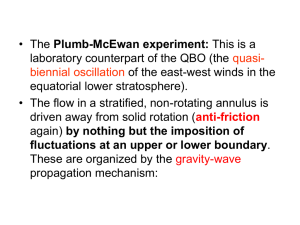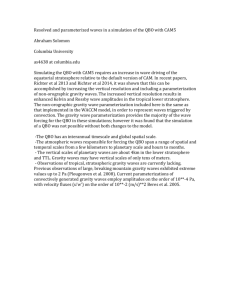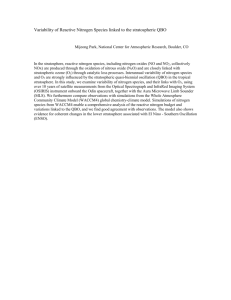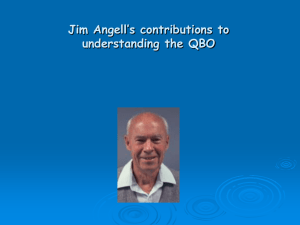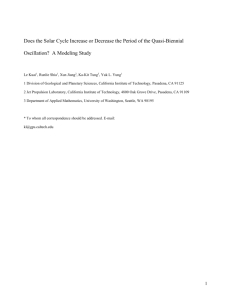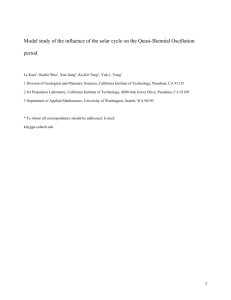KuaiQBOPeriod07 - California Institute of Technology
advertisement
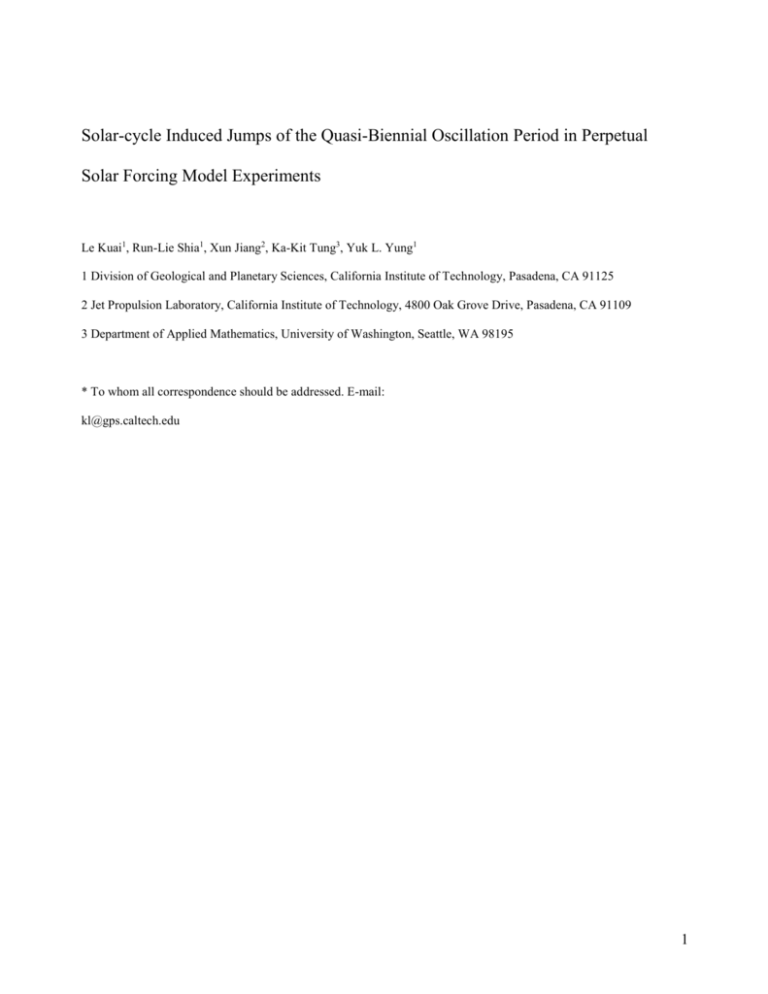
Solar-cycle Induced Jumps of the Quasi-Biennial Oscillation Period in Perpetual Solar Forcing Model Experiments Le Kuai1, Run-Lie Shia1, Xun Jiang2, Ka-Kit Tung3, Yuk L. Yung1 1 Division of Geological and Planetary Sciences, California Institute of Technology, Pasadena, CA 91125 2 Jet Propulsion Laboratory, California Institute of Technology, 4800 Oak Grove Drive, Pasadena, CA 91109 3 Department of Applied Mathematics, University of Washington, Seattle, WA 98195 * To whom all correspondence should be addressed. E-mail: kl@gps.caltech.edu 1 Abstract: Using a two-and-a-half dimensional THINAIR model, we examine the mechanism of solar-cycle modulation on the Quasi-biennial Oscillation (QBO) period. Observational evidence for the existence of such a modulation--an anti-correlation between the westerly QBO duration and the solar flux--is controversial because it is found only during a period (1960s to early 1990s) contaminated by volcano aerosols. However, this correlation in the longest available record was found to be near zero. In modeling, longer period runs without volcano influence can be obtained. The solar-cycle effect on the QBO period is rather subtle and complicated, with phase locking, beating and non-stationary behaviors. For conceptual understanding, the experiments are run with perpetual solar minimum/maximum conditions, which help us capture the features in the realistic case of periodic forcing. Both in our model and observed data, the QBO period is constant with height between 10-70 hPa. Under low solar forcing, the QBO period is phase-locked to a multiple (4) of Semi-Annual Oscillation (SAO) period (24 months). As solar forcing increases, the QBO period jumps with quantized multiple of the SAO periods, from 24 to 30 or 36 months. Because of this non-stationarity even under constant solar-cycle forcing, QBO periods do not respond one-toone to changing solar flux in the realistic case of periodic solar-cycle forcing. Therefore the statistical significant QBO-solar relationship cannot be established without a much longer observational record. The mechanisms responsible for solar modulation of QBO period are also discussed. 2 1. Introduction The Quasi-Biennial Oscillation (QBO) is an internal oscillation of the equatorial zonal wind in the stratosphere involving wave-mean flow interactions [Holton and Lindzen, 1972; Dunkerton, 1997; Baldwin et al., 2001]. There have been numerous observational studies of the QBO in the zonal wind, temperature, and ozone [e.g., Angell and Korshover, 1970; Oltmans and London, 1982; Hasebe, 1983; Zawodny and McCormick, 1991; Randel et al., 1996; Pawson and Fiorino, 1998]. The equatorial QBO affects the polar stratosphere during winter with the easterly phase of the QBO (e-QBO) creating the condition for a more perturbed and warmer polar vortex [Holton and Tan, 1980, 1982; Baldwin and Dunkerton, 1999, Ruzmaikin et al., 2005]. Therefore, the variation of the QBO period has additional significance, especially with respect to the timing of its phase relative to the northern winter [Baldwin et al. 2001]. The period of the QBO averages to about 28 months but is known to have inter-annual variations of a few months about the average. When the QBO was first discovered [Reed et al., 1961; Veryard and Ebdon, 1961], it was found to have a period of 26 months, 13 months each of easterly and westerly phase at 50 hPa. Later it was reported to have a period of 30 months (for the record 1979-1992) and now a little longer than 28 month using the longest data from Free University of Berlin (FUB) [Baldwin et al., 2001; Fischer and Tung, 2007]. While it is not surprising for this phenomenon arising from wave-mean flow interaction to have a variable period, the possibility that it could be affected by external forcing such as the 11-year solar cycle is intriguing. Using radiosonde data from FUB near the equator at 45 hPa between 1956-1996, Salby and Callaghan [2000] found that the duration of the equatorial westerly phase QBO (w-QBO) appears to vary with the solar cycle (SC) and tends to be longer during the solar minima (SC-min; we will use “SC-max” to refer to solar maxima). By comparison, the e-QBO duration has little variability at 3 that level, but has a decadal variation above 30 hPa. Soukharev and Hood [2001] extended the work of Salby and Callaghan [2000] using composite mean analysis of a similar dataset but at 50 to 10 hPa from 1957 to 1999. Their analysis also indicated that the duration of both QBO phases is longer during the SC-min. Pascoe et al. [2005] examined the ERA-40 data set from 1958 to 2001 to study the solar modulation of the mean descent rate of the shear zone. It has been found that on average, it requires two more months for the easterly shear zone to descend from 20 to 44 hPa under the SCmin condition and that the w-QBO duration increases (decreases) under the SC-min (SC-max) condition. This relation, however, broke down during the 1990s. Later, Hamilton [2002] and Fischer and Tung [2007] employed longer FUB datasets and both found the opposite behavior in the 1950s, the late 1990s and 2000s. Although there is anti-correlation (correlation coefficient = -0.46) between the w-QBO duration at 50 hPa and the solar flux for the period of 1956-1996, Hamilton [2002] showed that the correlation coefficient is only -0.1 during the extended period of 1950-2001. Additionally, Fischer and Tung [2007], who applied the Continuous Wavelet Transform to determine the QBO period at 50 hPa for the longer record of 1953-2005, found that the correlation coefficient between the period of the QBO and a solar cycle is practically zero. These later work did not contradict the findings of the earlier authors. They merely pointed out that the behavior of the 60s, 70s, 80s and early 90s were the opposite to that of the other decades before and after this period. The possible cause is that the diabatic heating due to volcanic aerosols could lead to the stalling of the downward propagation of the QBO [Dunkerton, 1983]. It is suggested by Marguadt [1997] that the diabatic heating only retard the descent of the easerlies if the volcano aerosols are injected during an easterly phase. In the decades of interest of the QBO studies above, there were three major volcanic eruptions that enhanced aerosols production in the equatorial stratosphere, Agung in 1963, El Chichon in 1982 and Pinatubo in 1991. Due to the difference in timing, location 4 and height of the injection of the SO2, the effect on the QBO period may be different after each eruption. A few more decades without volcanic interference would be needed to obtain a statistically significant correlation with the solar cycle. This complication can be circumvented in a modeling experiment. An additional possibility considered here is that, with or without volcano aerosols in the stratosphere, the QBO period may respond to the solar-flux in a non-stationary manner, with apparently random changes even without being perturbed by external forcing. The effect of the solar-cycle forcing is detectable only if the record is over a hundred years long. Our approach is similar to the work of Mayr et al [2003], who used a two-dimensional model with parameterized gravity waves that generates the QBO and the SAO in the equatorial stratosphere. Our model has two important advantages: (1) It is a two-and-a-half dimension model, meaning that the planetary waves can propagate into the stratosphere and interact with the mean flow to produce Stratospheric Sudden Warming (SSW). (2) The downwelling associated with SSW remotely forces an enhanced upwelling near the equator that may be responsible for stalling the easterly phase of the QBO below 30 hPa, a feature that is missing in the Mayr et al model. Additionally, we hold the solar-cycle forcing constant in our model. Mayr et al’s experiment obtained using variable solar-cycle forcing generated a large number of harmonics, sub-harmonics and beats. They found that if the gravity wave forcing that generates the QBO is tuned such that the QBO period is 30 months in the absence of solar-cycle forcing, there is very little difference found in the QBO period with the addition of the solar-cycle forcing, even with 3 times the forcing magnitude. The situation becomes different if the QBO period in the absence of the solar-cycle forcing is tuned to 33 months, then the QBO period becomes sensitive to solar-cycle forcing. The authors attributed the difference in behavior to the fact that the first case is phase-locked into the 5 Annual Oscillation (and its semi-annual sub-harmonic, though not specifically the SAO), and this situation is stable with respect to solar-cycle forcing. For better understanding and to avoid complications arising due to multiple harmonics we here simplify the experimental setup for the purpose of clearer conceptual understanding and keep the solar-cycle forcing constant at either SCmin or SC-max conditions (or multiple of such conditions). Section 2 describes the model and the sources of the QBO and solar forcing used in the simulations, along with comparison with the assimilated data from the National Centers for Environmental Prediction (NCEP) reanalysis [Kalnay, et al., 1996; Kistler, et al., 2001]. Section 3 presents results on how the QBO period and its easterly and westerly phase durations are modulated by the solar forcing. A discussion of the mechanism, conclusions of this paper and future directions follow. 2. Model QBO and Comparison with NCEP The THINAIR (Two and a Half dimensional INterActive Isentropic Research) is an isentropic chemical-radiative-dynamical model. The model has zonally averaged dynamics and includes the three longest planetary waves, which are prescribed by observations at the tropopause level [Kinnersley and Harwood, 1993]. For this study, the planetary wave forcing at the tropopause is fixed at the 1979 year level derived from NCEP reanalysis data, annually periodic and repeated for all years. This choice reduces inter-annual variability of the planetary wave forcing, so that the (weak) influence of the SC on the QBO can be studied. It removes tropospheric variability of planetary waves, but retains stratospheric variability that is internally generated through wave-mean flow interaction and modulated by SC. The model uses an isentropic vertical coordinate above 350 K. Below 350 K a hybrid coordinate is used to avoid intersection of the coordinate layers with the ground. The version used in this study has 29 layers from the ground to ~100 km for dynamics and 6 17 layers from ground to ~60 km for chemistry. The model has 19 meridional grid points evenly distributed from pole to pole. The QBO-source term in the momentum equation uses parameterization of wave momentum fluxes from Kelvin, Rossby-gravity and gravity waves [Kinnersley and Pawson, 1996]. These momentum sources also force the SAO above the QBO. UARS/SOLSTICE spectral irradiance observation is used as the 11-year solar cycle. UARS/SOLSTICE data consists of the solar spectrum in UV 119-400 nm during 1991-2002, with 1nm resolution. The monthly data are extended to 1947-2005 using F10.7-cm as a proxy [Jackman, C., et al. 1996]. The yearly averaged data are integrated to give photon fluxes in wavelength intervals appropriate for the THINAIR model. The model is run with perpetual solar minima (the minimum value of the realistic solar oscillatory forcing is used for the duration of the simulation) or solar maxima (the maximum value of the realistic solar oscillatory forcing is used for the duration of the simulation). Sensitivity studies are also carried out with multiple of the SC-max/SC-min condition. The performance of the model has been reported in the literature [Kinnersley and Pawson, 1996]. Figure 1 (a) presents the modeling e-QBO and w-QBO duration versus pressure from 10 to 50 hPa under the SC-mean conditions. Near 10 hPa, the QBO period is dominated by its easterly phase. The e-QBO duration decreases and the w-QBO duration increases until they are about equal near 50 hPa. The QBO period, which is the sum of the easterly and westerly durations, changes little with height, as noted by Fischer and Tung [2007] to be an important feature of the observed behavior. Figure 1 (b) shows the corresponding behavior in the NCEP reanalysis and demonstrates that the model has the correct behavior as compared to the reanalysis data. Obscured in this observed composite average is the behavior observed during certain years in which the descent of the easterly phase of the QBO stalls between 30 and 40 hPa [Kinnersley and Pawson, 1996; Dunkerton and 7 Delisi, 1998]. During these years, the w-QBO duration can be twice as long as that of the e-QBO duration below the level of easterly stalling, near 50 hPa [Salby and Callaghan, 2000, Baldwin et al., 2001, Pascoe et al., 2005]. 3. Solar Cycle Influence on the QBO Period. 3.1 Full QBO period. With the time-dependent oscillatory solar forcing, determining the QBO period is not straightforward, since the period itself is changing with the solar cycle. A number of subjective and objective methods have previously been used in the literature to study the modulation of the solar forcing on the QBO period. However, with fixed solar forcing, the QBO period can be determined using its Fourier spectrum. Therefore in this paper we present the results of the simulations with constant solar-cycle forcing. We perform the simulation with the SC-min condition, 2×, 3× the SCmin conditions, the SC mean condition, the SC-max condition and 2×, 3× the SC-max conditions. Figure 2 shows the Fourier spectrum of the 70-year time series of the QBO zonal wind at equator at various altitudes. It is seen that the period of the QBO does not depend on height. Also shown in these figures are various cases with different (perpetual) solar-cycle forcing: black line for 1×SCmin case; red line for 1×SC-max case; blue line for 2×SC-max case. The results reveal a QBO period of 25.08 months for 1×SC-min, 31.85 months for the 1×SC-max and 36.01 months for the 2×SC-max conditions. Thus, the period of the QBO is unambiguously lengthened as the solar flux increases. The magnitude of the difference between SC-min and SC-max, about 7-8 months in the mean, is comparable to the magnitude of the decadal variation seen in the observed data (see e.g. Fischer and Tung, [2007]). (Note however, the exact magnitude of the change is a function of the tuning of the equatorial gravity wave parameterization in the model, and should not be taken too 8 seriously.) Also seen in the Fourier spectra are the 12-month annual cycle, and the QBO-annual beats, which result from the interaction of the QBO period with the annual cycle [Tung and Yang, 1994a, 1994b]. An interesting feature of broad Fourier spectrum peak (with two to three peaks straddling 24 months) can be seen in the solar-min run. We will return to its discussion later In Figure 3 we plot the QBO period as a function of the solar index in units of solar flux (one unit represents one half of the difference of solar flux between the SC-max and SC-min) over the pressure range from 10 to 50 hPa in the model. This establishes that the period of the QBO generally increases as the solar flux increases, contrary to the finding of previous authors that the period reaches a maximum during solar min. In this model there is no variation of the QBO period with height (Panel (a) has lines for 7 levels from 7-80 hPa overlapping and indistinguishable from each other). Above 30 hPa, it is the easterly duration which varies with solar flux (Figure 3 (b) and (c)), while below 30 hPa it is the westerly duration that varies with solar flux (Figure 3 (d)), consistent with the observational result of Fischer and Tung [2007]. An interesting feature revealed in Figure 3 (a) is the tendency of the QBO period to phase-lock with the SAO periods, with particularly strong phase-locking at even multiples of the SAO period (so that it is also phase-locked with the annual cycle). Once the QBO period was locked in a 24 months at 2SC-min, further reduction of the solar flux to 3SC-min does not seem to be able to change its period, thus forming a flat ledge in Figure 3 (a). At high solar flux (2×SC-max), the QBO period is again synchronized with the annual cycle and phase-locked at 36 months. The 3×SC-max case is slightly more variable, with a mean period at 38.3 months. The cases in between these two annually synchronized periods are interesting because they are non-stationary and almost linearly dependent on the solar flux: the averaged QBO period increases when perturbed by increasing solar fluxes. 9 Since the period of the QBO does not vary with height from 7-80 hPa, we look first for the mechanism of solar modulation of the QBO period above 7 hPa. A potential site of solar-QBO interaction is the stratopause, where strong solar UV-ozone interaction takes place. This is also where SAO transitions into QBO, with the former seeding the latter. Figure 4 shows the time-height cross section of the equatorial zonal wind in the model for various solar-cycle forcing. We direct the reader’s attention to the region near 3-7 hPa, where the SAO transitions into the QBO. As pointed out by previous authors (Lindzen and Holton [1968]; Dunkerton and Delisi, [1997]), the SAO’s alternating easterly and westerly shear zones serve to “seed” the QBO below. In particular, the onset of the westerly phase of the QBO is tied to the downward propagation of the westerly phase of the SAO. A QBO period starts with the zero-wind line associated with the westerly shear zone of the SAO descending into the QBO region below, and ends when next such westerly descent occurs, to replace the easterly QBO below, at a multiple of SAO period later. In this way the QBO period is quantized in units of SAO period. Lindzen and Holton [1968] found that “the appearance of successive westerly regimes at 30 km tends to be a multiple of 6 months”. Since there may be other factors that can affect the descent rate of the QBO from the upper to the lower stratosphere, at the lower stratosphere this is more of a “tendency” than a strict synchronization in reality [Dunkerton and Delisi, 1997]. The observation of Fischer and Tung [2007] that the QBO period is almost constant with height in the stratosphere suggests that if there were a strict synchronization with the SAO at the stratopause level, such synchronization should be observable below, but is not seen in observation and in this model. The finding here of nonstationary synchronization with the QBO may offer a partial explanation. Furthermore, the synchronization may occur for low solar-cycle forcing and could be perturbed by the forcing to jump to a higher SAO multiple. This is discussed below. 10 Panel (a) in Figure 4 shows the simplest case, a QBO period locked in 4 SAO periods (and 2 annual cycles), for 2×SC-min. The westerly phase of the QBO at 7 hPa lasts 1.5 SAO periods (consisting of westerly-easterly-westerly phases of SAO) and the easterly phase lasts 2.5 SAO periods (easterly-westerly-easterly-westerly-easterly phases of SAO). This case is so stable that the period remains 24 months for larger negative solar cycle forcing. Panel (b) shows the case for 1×SC-min, and is the next case in terms of complexity. The QBO period comprises 4 SAO periods most of the time, but the time series is non-stationary, and occasionally there is one or two QBO periods consisting of 5 SAO periods. As a result, the average QBO period is 25.08 months. Apparently the solar-cycle forcing is not strong enough to force the QBO period into 5 SAO periods permanently. There is also the possibility that an odd multiple of SAO periods is not stable with respect to annual-cycle perturbation (at least in this model). This non-stationary behavior is not well represented by Fourier analysis and it generates a broad Fourier spectrum in Figure 2, with multiple peaks that do not necessarily represent these discrete periods present in part of the record. Panel (d) shows the result with 1×SC-max condition. Similar to the 1×SC-min case, the time series is also non-stationary. A QBO period can comprise of 4 or 5 or 6 SAO periods (mostly 4 and 6 SAO periods), yielding an average QBO period of 31.85 months. Panel (c) shows the case of SC-mean (without solar-cycle forcing) and it appears to behave approximately as the average of 1×SC-min and 1×SC-max cases, with an average period of 28.59 months, which comprises mostly 5 and 4 SAO periods with an occasional 6 SAO periods. Panel (e) shows the behavior for 2×SC-max, where the QBO period time series becomes stationary again and phase-locked into 6 SAO periods. This is however not as stable as the 24 month phase lock at low solar-cycle forcing. With larger forcing, at 3×SC-max (not shown), the QBO is mostly phase- 11 locked at 6 SAO periods but with an occasional jump to 7 SAO periods, yielding an average period of 38.29 months. 3.2. Partition of the QBO period into westerly and easterly durations In this model, stalling of the easterly descent tend to occur at around 30 hPa. Below that level, the westerly duration becomes longer. The westerly duration lasts between one to two years. As the solar-cycle flux increases, the westerly duration becomes longer. Therefore it is the westerly duration near 50 hPa that is correlated with the solar flux, while the easterly duration there shows much smaller variability from one QBO period to the next. Since the next westerly phase is not initiated at the upper stratosphere until the westerly region in the lower stratosphere wanes---due to the filtering of the westerly waves by the lower stratospheric westerly region---the easterly phase above 30 hPa is correspondingly lengthened, and correlated with the solar flux. This is consistent with the finding of Salby and Callaghan [2000], except that here the correlation with the solar flux is positive instead of the anti-correlation found by them. 3.3. Comparison with the periodic solar-cycle case Because of the non-stationary behavior found even under constant solar-cycle forcing, instantaneous QBO periods may change apparently randomly and therefore are not expected to respond one-to-one changing solar flux in the realistic case of periodic solar-cycle forcing. Therefore the correlation or anti-correlation of the QBO period time series with the solar-cycle flux time series is expected to be low, and its statistical significance cannot be established until we have a much longer observational record. In Figure 4 (f), we show the case of the QBO response under realistic, periodic solar-cycle forcing. It is more non-stationary than the perpetual forcing case, as expected. The mean period of the QBO in this case lies between perpetual SC-min and perpetual 12 SC-max, with a broad (double peak) Fourier spectrum between 28.59 months and 31.76 months, closer to the case of perpetual SC-max than perpetual SC-min. Instantaneous correlation of the QBO period or its westerly duration at 50 hPa with the solar flux is small and not statistically significant during the observed 40-year period, consistent with the finding of Fischer and Tung [2007] who used the longest record from Free University of Berlin. Nevertheless, based on the result with the constant solar-cycle forcing, which shows that the QBO period is longer at larger solar forcing, we expect to be able to find a statistically significant correlation of the QBO period with the solar flux for a long enough time record. 4. Mechanisms for solar modulation of QBO period. The partition of the whole QBO period into its easterly and its westerly parts in the lower stratosphere depends on the equatorial upwelling rate of the global Brewer-Dobson circulation. Figure 5 shows the isentropic stream-function for the Brewer-Dobson circulation in the stratosphere in January. It shows a strengthened Brewer-Dobson circulation during SC-max conditions as compared to SC-min conditions. Under the SC-max conditions the planetary waves are more focused to mid and high latitudes, and there are more Stratospheric Sudden Warmings in the polar stratosphere during late winter [Camp and Tung, 2007]. Consequently the polar stratosphere is warmer and the Brewer-Dobson circulation is more downward in mid to high latitudes [Cordero and Nathan, 2005]. This could remotely force a stronger upwelling branch of the Brewer-Dobson circulation over the equator, which then slows the descent of the QBO shear zone and extends the QBO period. Because the QBO-induced secondary circulation itself is also upward for the easterly phase at the equator, the eQBO is more vulnerable to slowing and eventual stalling, which usually occurs near 30 hPa [Plumb 13 and Bell, 1982 (a), 1982 (b)]. Below the stalling level, the westerly phase persists without being replaced by the descending easterlies, leading to a longer westerly duration. This explains why the descent of the easterly shear zone is more vulnerable to stalling. In this model there is no local heating due to volcanic aerosols, and so the anomalous upwelling over the equator shown here is remotely forced by the breaking of planetary waves in the extra-tropics. This is the so-called “polar route” [Pascoe et al., 2005]. This feature of the stalling of the easterlies and the prolongation of the westerly duration below is absent in the 2D model of Mayr et al. [2003], which does not have planetary waves that interact with the mean flow altered by solar-cycle forcing. Consequently in their model the descent of the easterlies and westerlies are more uniform than here and than in the observed data. The prolongation of the westerly phase of the QBO in the lower stratosphere is an important feature of the observed decadal variation of the QBO period because it delays the onset of the next westerly descent into the stratosphere by filtering out the westerly waves. In the absence of the westerly wave momentum deposition, the easterly duration is lengthened in the upper stratosphere. In the observational result of Fischer and Tung [2007], the decadal variation of the easterly duration at 15 hPa is tied to that of the westerly duration at 50 hPa. This feature is also seen in this model. Another mechanism for solar influence on the period of QBO was proposed by Cordero and Nathan [2005], who employed a model simulation to show that the QBO circulation is slightly stronger (weaker) during the SC-max (SC-min), resulting in a shorter (longer) QBO period arising from wave-ozone feedback. They argued that this leads to the required diabatic heating that slows down the descent rate of the equatorial QBO. This wave-ozone feedback is not included in our model. 14 A second mechanism is the so-called equatorial route of local radiative heating by the increased solar flux in SC-max as compared to the SC-min. In this model the UV radiation of the solar cycle forcing interacts with ozone most strongly in the stratopause region, and the resulting diabatic heating affects the seeding of the QBO by the SAO. This solar perturbation serves to “kick” the QBO period from one SAO multiple into another, higher (on average) multiple. To test this hypothesis, we make another run by switching off the solar cycle-ozone feedback. Ozone in the model is then not allowed to change as solar cycle changes, but other interaction with dynamics are still allowed. The first run we made was for the 2SC-max perpetual case, hoping that the effect would be more detectable in an exaggerated solar flux. Surprisingly, no difference was found. The QBO period remains 36 months with or without the ozone interaction. From hindsight this may not be that surprising because of the phase-locking of the 2SC-max case, 36.01 month is more stable to small perturbations in radiative heating. So next we chose the non-stationary case of 1SC-max. In the non-interactive case, ozone is fixed at the SC-mean case, but the solar flux is increased to 1SCmax. The time-height cross section of the zonal wind is shown in Figure 6. The average period is 29.80 months without ozone feekback. The behavior is non-stationary, and lie between the SCmean (with an average period of 28.59 months) and 1SC-max (with an average period of 31.84 months) case with ozone feedback. In summary, we find two effective mechanisms of how a change in solar flux affects the period of the QBO: (1) through a change in the strength of the Brewer-Dobson circulation by its effect on planetary waves, and (2) by local heating change in the upper stratosphere. The first mechanism is a remote mechanism, and is absent in 2D models without inter-annual change in planetary wave propagation and dissipation. The second mechanism is local, and affects the magnitude of the radiative heating perturbation which “kicks” the QBO from one temporary phase-locking with the 15 SAO to another, higher (on average) multiple. The first mechanism, previously suggested, affects mainly the partition of the QBO into its easterly and westerly phases. Its effect on the QBO period is about one month or less. 5. Discussion and Conclusions It is well known that the polar stratosphere in winter is significantly more perturbed when the equatorial QBO is easterly than when it is westerly [Holton and Tan, 1980, 1982; Baldwin et al, 2001]. A mechanism that can affect the period of the equatorial QBO, by altering the timing of the phase of the QBO relative to the polar winter will therefore have a significant impact on the circulation of the entire stratosphere. The 11-year solar cycle has often been cited as able to modulate the equatorial QBO period, especially its westerly duration in the lower stratosphere. Salby and Callaghan [2000], Soukharev and Hood [2001] and Pascoe et al [2005] found evidence in the observed data that the westerly phase duration of the QBO in the lower stratosphere is lengthened during solar minima. While confirming these results, Hamilton [2002] and Fischer and Tung [2007] found with longer data sets that perhaps the opposite may be hold during other decades, which coincidentally did not have volcanic aerosol contamination. The record is not long enough for us to establish the behavior of the solar-cycle modulation of the QBO period in a clean stratosphere, although it is not clear if the volcanoes were the culprit. In the present model where there is no volcanic influence and long runs are possible, we have established that the QBO period is lengthened during solar maxima, and that the increase in period is proportional to the solar-cycle forcing. We also find that such an effect is difficult to establish without a long time record because of the presence of non-stationary behavior, whereby the QBO period can change even if the solar flux is held constant. 16 To understand the mechanism of solar-cycle modulation of the QBO period, model runs with perpetual SC-min or SC-max conditions are performed. We find a tendency of the QBO period to synchronize with the SAO period. That the observed mean period (e.g. 28 month) is not always a multiple of six months can be partially explained by the fact that the QBO period is non-stationary even when the solar forcing is constant. Two exceptions occur at 24 months and 36 months, forced by 2SC-min forcing and 2SC-max conditions. These two periods are more stable because there is also a synchronization with the annual cycle. In between these two cases there are temporary (nonstationary) quantum jumps of the QBO period by a SAO period when the stratopause region is perturbed by the solar cycle, yielding non-integer multiples of the SAO period as the average period of the QBO. The magnitude of the average period is proportional to the solar-cycle flux. In the model two mechanisms are responsible for the solar influence of the QBO period: a radiative perturbation of the SAO-QBO transition region when ozone production is enhanced by the increased solar flux; a dynamical mechanism which increases the strength of the Brewer-Dobson circulation. The work reported here is a preliminary study of the influence of the solar cycle on the QBO period using the THINAIR model. Further study is needed on the cases driven by a realistic timedependent solar cycle forcing. More simulations will be performed to study the influence of volcanic aerosols on QBO to explain the puzzling results between 1960 and 1995. Ultimately, the results obtained here must be verified in a three-dimension general circulation model such as the Whole Atmosphere Community Climate Model (WACCM) [Garcia et al., 2007]. Acknowledgements: This work was supported in part by NASA grants NAG1-1806 and NNG04GN02G to the California Institute of Technology. K. K. Tung’s research was supported in 17 part by NSF grant ATM 332364. We would like to thank A. Ruzmaikin and J. Feynman for useful discussions and K.-F. Li of Caltech for his solar flux data and helpful suggestions. We also acknowledge M. C. Liang, N. Heavens, X. Guo, A. Soto and T. Lee for their comments of the paper. 18 References: Angell, J. K., and J. Korshover (1970), Quasi-Biennial, Annual, and Semiannual Zonal Wind and Temperature Harmonic Amplitudes and Phases in Stratosphere and Low Mesosphere of Northern Hemisphere, J. Geophys. Res., 75 (3), 543-550. Baldwin, M. P., and T. J. Dunkerton (1999), Propagation of the Arctic Oscillation from the stratosphere to the troposphere, J. Geophys. Res., 104(D24), 30,937-30,946. Baldwin, M. P., L. J. Gray, T. J. Dunkerton, K. Hamilton, P. H. Haynes, W. J. Randel, J. R. Holton, M. J. Alexander, I. Hirota, T. Horinouchi, D. B. A. Jones, J. S. Kinnersley, C. Marquardt, K. Sato, and M. Takahashi (2001), The quasi-biennial oscillation, Rev. Geophys., 39 (2), 179-229. Camp, C. D., and K. K. Tung (2007), The influence of the solar cycle and QBO on the late-winter stratospheric polar vortex, J. Atmos. Sci., 64(4), 1267-1283. Cordero, E. C., and T. R. Nathan (2005), A new pathway for communicating the 11-year solar cycle signal to the QBO, Geophys. Res. Lett., 32(18), art. no L18805. Dunkerton, T. J. (1983), Modification of stratospheric circulation by race constituent changes?, J. Geophys. Res., 88, 10,831-10,836. Dunkerton, T. J. (1997), The role of gravity waves in the quasi-biennial oscillation, J. Geophys. Res., 102(D22), 26053-26076. Dunkerton, T. J. and D. P. Delisi, (1997), Interaction of the quasi-biennial oscillation and stratopause semiannual oscillation, J. Geophy. Res., 102(D22), 26107-26116. Fischer, P., and K. K. Tung (2007), A reexamination of the QBO-period modulation by the solar cycle using continuous wavelet transform, Submitted to Geophys. Res. Lett.. Garcia, R. R., et al. (2007), Simulation of secular trends in the middle atmosphere, 1950-2003, J. Geophys. Res., 112(D9), art. no D09301, doi:10.1029/2006JD007485. 19 Hamilton, K. (2002), On the quasi-decadal modulation of the stratospheric QBO period, J. Climate, 15(17), 2562-2565. Hasebe, F. (1983), Interannual variations of global total ozone revealed from Nimbus 4-Buv and Ground-based observations, J. Geophys. Res., 88(NC11), 6819-6834. Holton, J. R., and R. S. Lindzen (1972), Updated theory for Quasi-Biennial Cycle of tropical stratosphere, J. Atmos. Sci., 29(6), 1076-1080. Holton, J. R., and H. C. Tan (1980), The influence of the equatorial quasi-biennial oscillation on the global circulation at 50 mb, J. Atmos. Sci., 37(10), 2200-2208. Holton, J. R., and H. C. Tan (1982), The quasi-biennial oscillation in the northern hemisphere lower stratosphere, J. Meteor. Soc. Japan, 60(1), 140-148. Jackman, C., E. L. Fleming, S. Chandra, D. B. Considine, and J. E. Rosenfield (1996), Past, present, and future modeled ozone trends with comparisons to observed trends, J. Geophys. Rev., 101(D22), 28753-28767 Kalnay, E., M. Kanamitsu, R. Kistler, W. Collins, D. Deaven, L. Gandin, M. Iredell, S. Saha, G. White, J. Woollen, Y. Zhu, M. Chelliah, W. Ebisuzaki, W. Higgins, J. Janowiak, K. C. Mo, C. Ropelewski, J. Wang, A. Leetmaa, R. Reynolds, R. Jenne, and D. Joseph (1996), The NCEP/NCAR 40-year reanalysis project, Bull. Am. Meteorol. Soc., 77(3), 437-471. Kinnersley, J. S., and R. S. Harwood (1993), An isentropic 2-dimensional model with an interactive parameterization of dynamical and chemical planetary-wave fluxes, Q. J. R. Meteorol. Soc., 119(513), 1167-1193. Kinnersley, J. S., and S. Pawson (1996), The descent rates of the shear zones of the equatorial QBO, J. Atmos. Sci., 53(14), 1937-1949. 20 Kistler, R., E. Kalnay, W. Collins, S. Saha, G. White, J. Woollen, M. Chelliah, W. Ebisuzaki, M. Kanamitsu, V. Kousky, H. van den Dool, R. Jenne, and M. Fiorino (2001), The NCEP-NCAR 50year reanalysis: Monthly means CD-ROM and documentation, Bull. Am. Meteorol. Soc., 247-267. Lindzen, R. S., and J. R. Holton (1968): A theory of the quasi-biennial oscillation, J. Atmos. Sci., 25, 1095-1107. Marquadt, C. (1997), Die tropische QBO und dnamische Prozesse in der Stratosphaere, Meteorolo. Abh., Ser. A, 9, D. Reimer, Berlin. Mayr, H. G., J. G. Mengel, D. P. Drob, H. S. Porter, and K. L. Chan (2003), Modeling studies with QBO: I. Quasi-decadal oscillation, J. Atmos. Terr. Phys., 65(8), 887-899. Mayr, H. G., J. G. Mengel, D. P. Drob, H. S. Porter, and K. L. Chan (2003), Modeling studies with QBO: II. Quasi-decadal oscillation, J. Atmos. Terr. Phys., 65(8), 901-916. Oltmans, S.J., and J. London (1982), The Quasi-Biennial Oscillation in Atmospheric Ozone, J. Geophys. Res., 87(NC11), 8981-8989. Pascoe, C. L., L. J. Gray, S. A. Crooks, M. N. Juckes, and M. P. Baldwin (2005), The quasibiennial oscillation: Analysis using ERA-40 data, J. Geophys. Res., 110(D8), D08105, doi:10.1029/ 2004JD004941. Pawson, S., and M. Fiorino (1998), A comparison of reanalyses in the tropical stratosphere. Part 2: The quasi-biennial oscillation, Clim. Dyn., 14(9), 645-658. Plumb, R. A., and R. C. Bell (1982a), Equatorial waves in steady zonal shear flow, Q. J. R. Meteorol. Soc., 108(456), 313-334. Plumb, R. A., and R. C. Bell (1982b), A model of the quasi-biennial oscillation on an equatorial beta-plane, Q. J. R. Meteorol. Soc., 108(456), 335-352. 21 Randel, W.J., and F. Wu (1996), Isolation of the ozone QBO in SAGE II data by singular-value decomposition, J. Atmos. Sci., 53(17), 2546-2559. Reed, R.J., L. A. Rasmusse, W. J. Campbell, and D. G. Rogers (1961), Evidence of a downwardpropagating, annual wind reversal in equatorial stratosphere, J. Geophys. Res., 66(3), 813-818. Ruzmaikin, A., J. Feynman, X. Jiang, and Y. L. Yung (2005), The extratropical signature of the Quasi-Biennial Oscillation, J. Geophys. Res., 110(D11), doi:10.1029/2004JD005382. Salby, M. L., and P. F. Callaghan (2000), Connection between the solar cycle and the QBO: The missing link, J. Climate, 13(14), 2652-2662. Soukharev, B. E., and L. L. Hood (2001), Possible solar modulation of the equatorial quasibiennial oscillation: Additional statistical evidence, J. Geophys. Res., 106(D14), 14,855-14,868. Tung, K. K., and H. Yang (1994a), Global QBO in circulation and ozone: 1. Reexamination of observational evidence, J. Atmos. Sci., 51(22), 2699–2707. Tung, K. K., and H. Yang (1994b), Global QBO in circulation and ozone: 2. A simple mechanistic model, J. Atmos. Sci., 51(22), 2708-2721. Ebdon, R. A., and R. G. Veryard (1961), Fluctuations in tropical stratospheric winds, Nature, 189(476), 791. Zawodny, J.M., and M.P. McCormick (1991), Stratospheric Aerosol and Gas Experiment-Ii Measurements of the Quasi-Biennial Oscillations in Ozone and Nitrogen-Dioxide, J. Geophy. Res., 96(D5), 9371-9377. 22 Figure 1. (a) Composite mean of e-QBO duration (*) and w-QBO duration (+) versus pressure from the THINAIR model under the SC-mean condition. (b) Same as (a) except using NCEP reanalysis. 23 Figure 2. Fourier power spectra of the 70-year zonal wind time series from the THINAIR model; black line for 1×SC-min case; red line for 1×SC-max case; blue line for 2×SC-max case. (a) at potential temperature level 712 K (~15 hPa); (b) 595 K (~ 26 hPa); (c) 499 K (~ 41 hPa); (d) 421 (~66 hPa) 24 Figure 3. (a) QBO period as a function of solar-cycle forcing obtained using the THINAIR model for five levels from 7-80 hPa. Lines overlap, showing that the period does not change with height. Composite mean of e-QBO duration (*) and w-QBO duration (+) versus solar forcing (b) 10 hPa, (c) 20 hPa, (d) 50 hPa. 25 Figure 4. Time-height section of the equatorial monthly-mean zonal wind component (in m s-1) from the THINAIR model simulation. The individual QBO period is synchronized with SAO near stratopause. The black line is the zero-wind line. (a) 2×SC-min perpetual condition; (b) 1×SC-min perpetual condition; (c) SC-mean perpetual condition; (d) 1×SC-max perpetual condition; (e) 2×SCmin perpetual condition. (f) under realistic periodic solar-cycle forcing from 1×SC-min to 1×SCmax. 26 Figure 5. (a) Mass stream function on isentropic surfaces in units of 109 kg s-1 under SC-min condition. (b) The difference between the composites of the 1×SC-max and 1×SC-min. Both figures are for Jan. 27 Figure 6. The same as Figure 4 but under 1×SC-max condition (a) with ozone feedback (b) without ozone feedback 28
